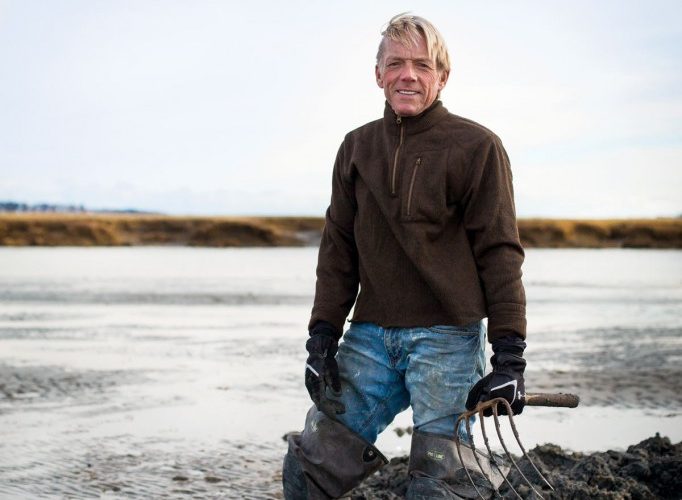Small yet significant, the clam has long been a symbol of life on the North Shore.
From food to commerce, the mighty clam is a cultural mainstay across New England. Tourists flock to famous fried clam shacks and descend upon sandy beaches at low tide to dig for their dinner. This abundant shellfish doesn’t have the prestige of an oyster or universal appeal of shrimp, but it holds a special place in the hearts of many right here on the North Shore.
Jack Grundstrom and his son John are third- and fourth-generation clammers in Rowley. Reflecting on his decades spent bent over the mud flats, Jack says the business hasn’t changed much. “My father was doing the exact same thing in 1930 that John does in 2013,” he says. Though conditions and prices may vary from year to year, the process is the same whether you’re a professional digger or a novice: Find an approved mud flat to dig at low tide, look for tiny air holes in the sand, use a clam fork to carefully rake around the spot, and then dig with your hands until you can carefully extract the clam.
The experience can take seconds for a seasoned digger and several minutes for a novice. There are no short cuts, no “honey holes” of clustered clams easily plucked by the handful—it’s one clam at a time. Throughout the blistering heat of summer and icy chill of winter, many in the region still make a living following the tide charts day after day. The Grundstroms are passionate advocates of the clam trade, teaching both young and old about this lost art. “If you didn’t go clamming, you didn’t eat,” Jack recalls of his childhood.
Clams as Food
Joseph Carlin, a food historian, clam expert, and North Shore resident, has been studying clams for years, amassing a collection of documents relating to clam consumption and folklore. He says clams suffered an image problem for the first part of the 19th century. “They were used for bait and pig food, lived in mud, and were harvested for trade by Native Americans. The clam carried a lot of baggage, so people weren’t quick to embrace it,” he says.
Change came after the Civil War, when trains and ferries carried tourists to the many newly built resort hotels lining the shores from Long Island to Maine. Searching for clams in the sand became a fun activity for families, and soon clams made their way to the kitchen, into chowders, fried, and as part of the quintessential clambake.
Carlin says the rise in automobile travel and road infrastructure led to the establishment of clam shacks. These weather-beaten structures were located on the side of the road for convenience, luring people to stop in for “dressed clams” (shucked) and other snacks. Clam shacks sprung up in the Joppa Flats area of Newburyport, in Ipswich along “Clamshell Alley” (now known as Water Street), and along Route 22, the most famous of them all, Woodman’s.
The Legacy of the Fried Clam
Still a family-owned establishment, Woodman’s has been recognized as a part of American gastronomic history. No one knew a good business opportunity better than Lawrence “Chubby” Woodman. Though he is credited with inventing the fried clam, this is not true; the first known mention of frying clams is documented in an American cookbook dating from 1852, and on the North Shore, fried Ipswich clams were listed on a menu from the reopening of the Plum Island Hotel in 1886.
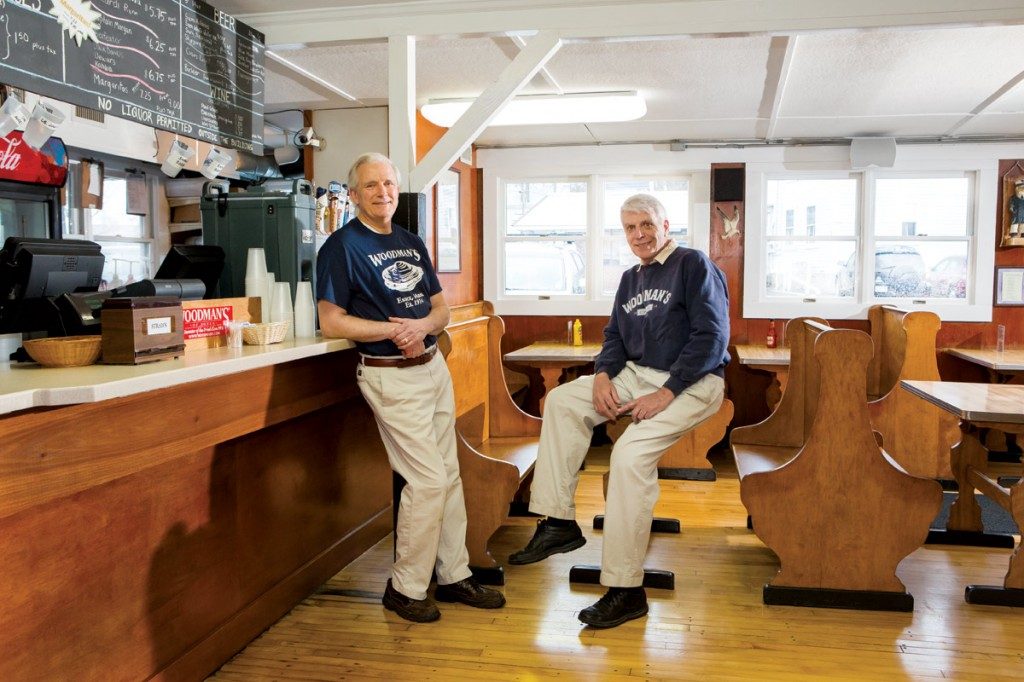
Steve and Leonard Woodman
But Chubby was the first person to actively promote and sell fried clams to customers, creating a legacy. It all started in 1914 when Chubby began selling shucked raw clams, fried potatoes, and Beech Nut cigarettes in a little shack located next to his primary source of income, a diner (now Dunkin’ Donuts). Leonard Woodman, Chubby’s oldest grandson, remembers selling clams to his grandfather at a young age, making five dollars a bushel. As Leonard tells the story, Chubby was sitting around at high tide in the clam shack when one of his friends suggested he fry a clam. After trial and error, his wife Bessie eventually came up with the winning recipe, which used cornmeal batter. On July 3, 1916, they sold the first Woodman’s fried clam, a momentous occasion that Bessie recorded on the back of their marriage certificate.
Despite their popularity, fried clams were not the main reason for Woodman’s becoming a mustn’t-miss destination. At the time, Route 22 was the main passage to Boston, and Chubby knew giving people a reason—and a place—to stop was paramount. So he built a parking lot. This foresight is a huge part of Woodman’s success. “Toward the end of his life, he’d sit and watch all the cars in the parking lot and smile,” says Steve Woodman, who currently runs his grandfather’s business. During July and August, a line snakes out the door, serving up to 2,000 fried clams a day.
Soft-shell clams are mostly consumed in New England, either fried or steamed. Those outside this geographic area are often wary of eating the clam belly, something hotel and restaurant magnate Howard Johnson discovered when he was trying to popularize fried clams on his menu across the country. Though Chubby taught him how to fry belly clams, Johnson ultimately focused his efforts on the clam strip. It was Ipswich resident Thomas Soffron (who also detested the bellies) who invented a patented device used to tenderize the tough surf clam meat used to make the strips. His Soffron Brothers clam processing plant supplied clam strips to Howard Johnson for more than a decade. (The plant shuttered its doors in 1988 and is now the site of the new Ipswich Ale brewery.)
The Complex Clam
Five species of clams make up most of the commercial harvest in the United States: quahog, surf clams, soft-shell clams (steamers or fried), hard-shell clams (littleneck or cherrystone), and manila clams. On the North Shore, the term “Ipswich” clam often refers to the signature sweet soft-shell clam harvested in Ipswich and Essex and on Plum Island.
By law, commercial clammers must sell to dealers or wholesalers, who in turn sell to restaurants and stores. To ensure that the product is always clean and healthy, each bag of clams is tagged and tracked to the area from which they came and to the person who dug them. Last year was one of the best clamming years in recent history, and 2013 is also off to a great start.
The Massachusetts Department of Fish and Game has 28 designated shellfish growing areas across the North Shore. Each area (labeled from N1 to N28) falls under the responsibility of a town-designated shellfish constable who ensures safety, regulates closures, issues permits, and monitors environmental impact.
In the 1930s, the European green crab began devastating the harvest, eating up to 200 soft-shell clams a day. More recently, the Asian shore crab has impacted the shell fishing ecosystem, likely traveling in ship ballast waters to this region. This “boom-or-bust industry,” as Gloucester Shellfish Constable Dave Sargent calls it, has also changed drastically over the past 20 to 30 years due to health regulations.
“I remember when things [were] different,” Sargent says. “Clamming was a much more predictable and reliable occupation.” Sargent’s job is 24 hours a day, seven days a week, with each day beginning with a pre-dawn awakening to check conditions. Any precipitation can be cause for closure of clam flats, or digging areas, sometimes up to three weeks or a month. And for commercial clammers, the economical impact is big. “Clams are the largest contributor to the commercial market. When clamming is good, a digger can pull up to his maximum 200 pounds a day in four to five hours,” Sargent says. When demand for clams is high, wholesalers can pay up to $2.50 per pound.
Besides weather, Sargent has to monitor overharvesting by constantly rotating areas and limiting their usage to certain days of the week. Updates are given via recorded hotline every morning, the main source of information for most commercial clammers. The city issues 100 commercial and 300 to 400 recreational permits a year, the latter of which is an enforcement nightmare, according to Sargent, as many people aren’t even aware they need a permit, or they dig in restricted areas. Permits range from $25 a day for non-resident non-commercial to $400 a year for commercial residents.
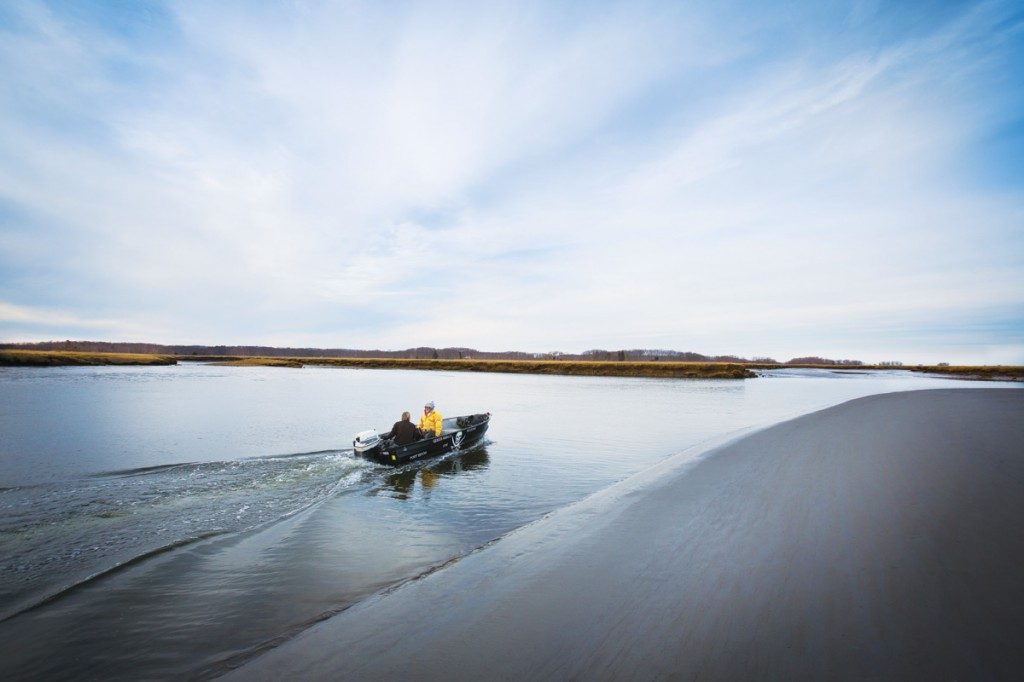 Boating to the flats
Boating to the flatsA Life Worth Digging
Like many in their trade, the Grundstroms are skilled in other areas to offset tough seasons. John, nicknamed “The Golden Boy” by fellow clammers for his uncanny ability to be at the right place at the right time to make a profit, also goes to Key West to fish for sea sponges and is a silversmith, among other things. His father has dabbled in real estate, property management, and engineering, but clamming runs through the men’s veins. As John says, “I look at myself as one of the luckiest people there is—every day [that] I get up to go to work, [I look] forward to it.” He describes clamming as a treasure hunt; the challenge of finding each elusive clam provides the same adrenaline rush as searching for gold.
The Grundstroms’ family tree extends across many areas of the business: Savage Seafood, a distributor in Rowley, and the Clam Box, established in 1935 in Ipswich. John’s 19-year-old daughter is now carrying on the family legacy, digging during summer breaks from college. He beams with pride when he recalls how, at 15 years old, she was awarded a certificate by Ipswich Maritime for being paid the highest amount ever for a female digger.
The tradition of clamming holds many families, like the Woodmans and the Grundstroms, together through the generations. Clammers are independent, tenacious, and loyal—traits that make them a tight-knit community here on the North Shore. Despite the competitive nature of the business (you never dig too closely to another clammer, and you never give up your special digging spots), John says they all watch out for each other when times are good and when times are bad, adding, “No one leaves a flat before the last man does.”
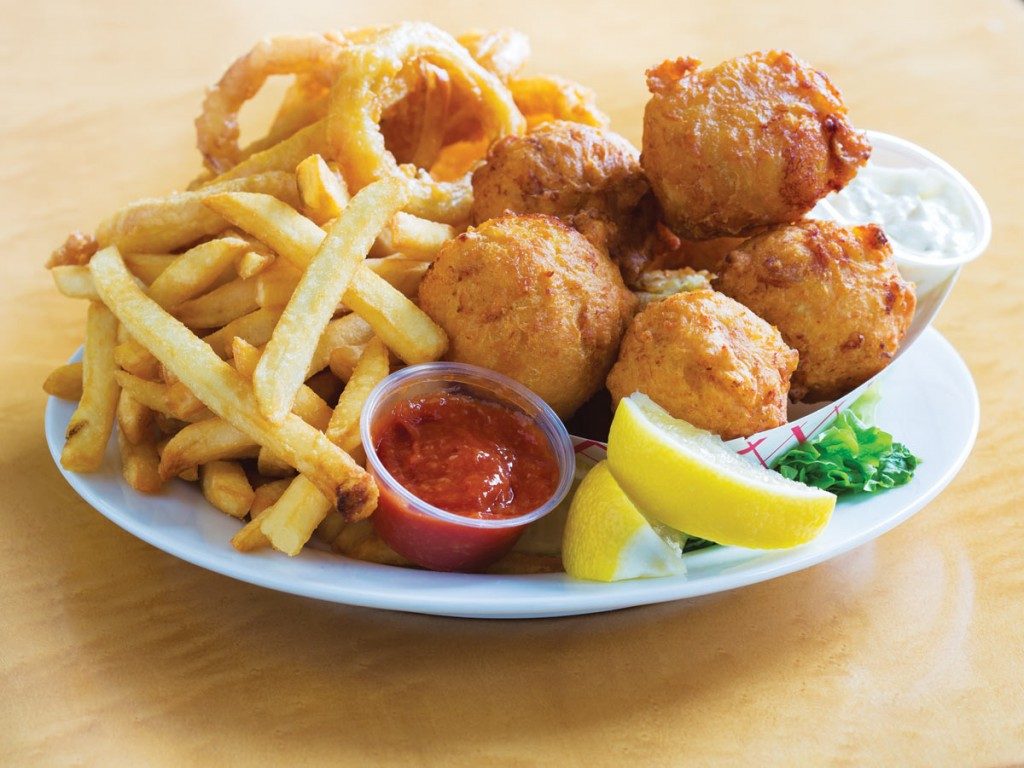 Woodman’s Clamcakes
Woodman’s ClamcakesClamcakes, Woodman’s famous recipe
Ingredients
- Lard for frying
- 1 c. drained/strained minced clams
- 3 tbsp. clam juice
- 1 egg
- 1 c. all-purpose flour
- 2 tsp. baking powder
- 1/2 tsp. salt
Directions – In a deep pan, add lard to fill to 1-2 inches and heat to 285°F. While oil is heating, strain clams and reserve the juice (if there isn’t enough juice, add water). In a mixing bowl, mix together flour, baking powder, and salt. Add in clams, egg, and clam juice, then mix with spatula or wooden spoon until well blended. (If using a mixer, use dough hook.) When oil is hot, use teaspoon to make rounded balls about 1 inch in diameter and carefully spoon into the oil. Flip the cakes continually until dark golden brown all over.
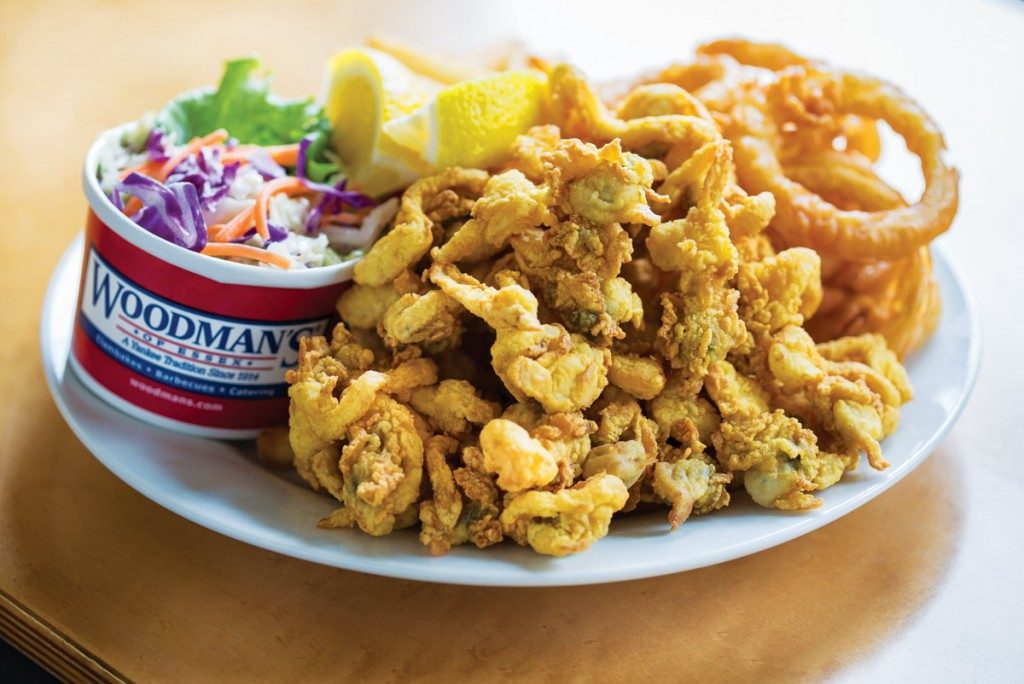 Woodman’s Fried Clams
Woodman’s Fried ClamsFried Clams, Recipe courtesy of Woodman’s of Essex
Equipment
- Fry Daddy (or other electric home fryer), cast iron skillet, or heavy fry pan
- Bowl containing can of evaporated milk
- Strainer for straining off excess evaporated milk
- Cookie sheet lined with corn flour
Fat
- Enough lard, vegetable oil, or Crisco that when melted gives you 2-3 inches of liquid in your pan. If using an electric fryer, fill as directed by manufacturer.
- Temperature 350°F
Ingredients
- Corn flour
- Evaporated milk
Directions – Heat lard up to 350°F. Working with a small handful at a time, dip clams into bowl of evaporated milk. Strain off excess evaporated milk. Put strained clams in corn flour and fluff until evenly coated. Shake off any excess corn flour. Carefully immerse clams, in small batches, into hot fat. Take care not to crowd clams during frying. Stand back from fryer during cooking to avoid spattering oil. Listen to them sizzle. When they start to quiet down (roughly 1 minute and 15 seconds), scoop them out with a slotted or mesh utensil. Clams should be golden in color. Make sure they are crisp. Test. Be sure not to undercook the clams, as they will be soggy and greasy, but also be sure not to overcook, as they will be rubbery. Drain cooked clams on paper towel. Season to taste with salt and pepper; serve with lemon wedges, tartar sauce, or ketchup.

